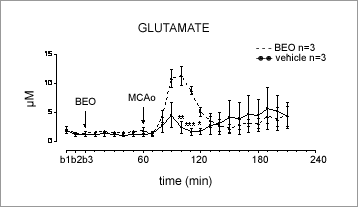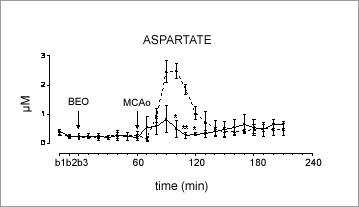Print version
Search Pub Med
Evidence that systemic administration of the essential oil of bergamot minimizes elevation of glutamate and aspartate in the brain cortex of ischemic rat 111121
Bergamot essential oil (BEO) is obtained from cold press of epicarp and, partly, of the mesocarp of the fresh fruit of Citrus bergamia Risso. BEO comprises a volatile fraction (93-96% of total) containing terpenes and oxygenated derivatives and a non volatile fraction (4-7% of total) containing cumarines and furocumarines (Di Giacomo et al., 1993). Here we demonstrate that the neuroprotective effect of BEO in a rat model of permanent focal brain ischemia involves modulation of excitatory aminoacid efflux in the ischemic cortex. Male Wistar rats (250-300g) were anaesthetised with chloral hydrate (0.4g/kg-1 i.p.) and a microdialysis probe was implanted in the upper frontoparietal cortex. 24 h after surgery, animals were re-anesthetised with urethane (1,5 g/kg -1 i.p.) and the microdialisys probe perfused with artificial CSF (mM: NaCl, 125; KCl, 2.5; MgCl2, 1.18; CaCl2, 1.26; NaH2PO4, 0.2; pH adjusted to 7.0) at a flow-rate of 2 μl/min. After 1 h stabilisation period, dialysate samples were collected every 10 min for 1 h to establish basal amino acid levels. At this point, BEO or vehicle (vegetable oil) were administered i.p. and 10-min dialysate samples collected for a further 1 h. At the end of collection, middle cerebral artery occlusion MCAo was performed by insertion of a silicon-coated nylon filament ( 0.28 mm diameter) through the internal carotid artery and sample collection continued for further 3 h. Concentrations of glutamate (glu), aspartate (asp), glycine (gly), GABA, glutamine (gln), taurine (tau) and citrulline (cit) were determined by HPLC (Richards et al., 2000). Administration of BEO, 1 h before MCAo, resulted in a dose-dependent reduction of brain infarct volume (mm3: vehicle 543 + 18; BEO 0.05 ml/kg, 416 + 49; BEO 0.1 ml/kg, 397 + 25*; BEO 0.5 ml/kg, 344 + 33***; *P<0.05 and ***P<0.001 vs vehicle, ANOVA + Dunnett’s, n = 4-6) as detected after 24 h ischemia by the triphenyltetrazolium chloride (TTC) staining technique .At the dose that exerted maximal neuroprotection (0.5 ml/kg), BEO did not affect basal aminoacid levels, whereas it significantly reduced excitatory aminoacid, namely asp and glu, efflux in the frontoparietal cortex typically observed following MCAo (see Figure, *P<0.05, **P<0.01, ***P<0.001 vs vehicle, Student’s t-test). By contrast, extracellular levels of gly, GABA, gln, tau and cit were not affected. Thus, inhibition of excitatory aminoacids increase might represent a pivotal mechanism involved in the neuroprotection exerted by BEO against MCAo-induced brain damage.
Di Giacomo et al. (1993). Gli Olii agrumari in Italia. L aruffa Ed., pp. 91-102 |
|



